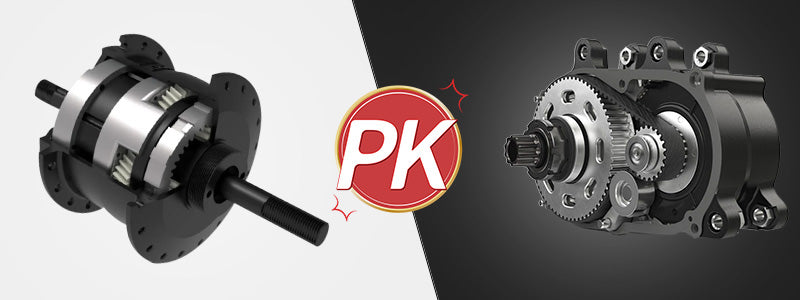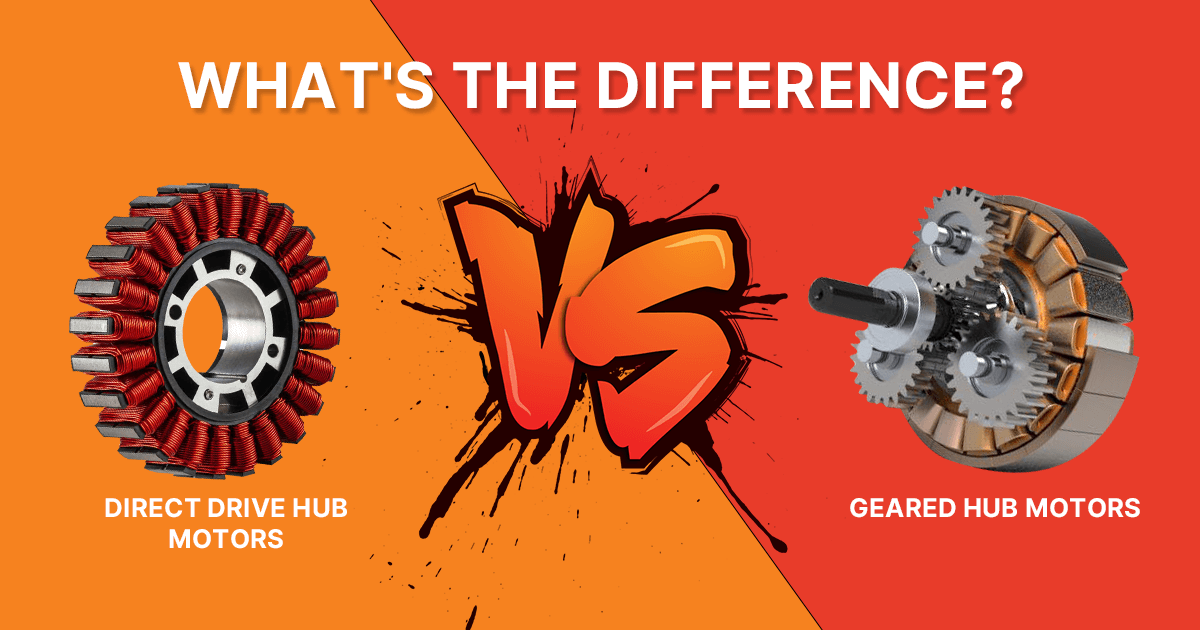Ever wondered why most electric bikes are equipped with hub motors instead of mid drive motors? After reading this article you’ll have a comprehensive knowledge of e-bike motors, and which one is the best choice for you.
Nowadays, electric bikes motors are usually either equipped with a mid drive motor or hub motor depending on the mounting position. The choice of motor system can greatly affect the quality of your ride and it is important to understand the differences before buying an e-bike so that you can choose the best type of motor for you.
In a previous article we compared the common types of hub motors (gear hub motor vs direct drive motor) which are usually mounted on the front or rear wheel of the electric bike. In this article, we will discuss the differences between hub motors and mid drive motors.
Overview of hub motor
What is a hub motor?
Both types of hub motors provide propulsion by spinning the wheels. The front hub motor gives the feeling of the bike being "pulled" forward, while the rear hub motor "pushes" the rider forward, making the rider feel more natural, like a conventional bike.
Working principal of a hub motor
As mentioned above, there are two types of hub motors: gear hub motor and direct drive motor.

At present, most electric bicycles are installed with geared hub motors, which have a simple structure of copper coils, stators, magnets, and motor covers, driving the axle to rotate through the mechanical energy formed by electromagnetic induction between the coils and the stators.
Overview of mid drive motor
What is mid drive motor?
A mid drive motor is installed directly between the pedals at the bike’s bottom bracket.
Unlike a hub motor, a mid drive motor delivers power to the bike's drivetrain rather than to the axle. Its central position creates a more natural riding feel than a hub motor, comparable.
Working principal of mid drive motor

The mid drive motor, also known as a differential motor, has a complex transmission system with a core of motor, differential, and drive chain.
Instead of applying electrical energy directly to the drivetrain after converting it to kinetic energy, the mid drive motor has to pass through a series of derailleurs that amplify torque and reduce speed. Therefore, for electric bicycles, the motor power output shaft and the bicycle's gear shaft are structurally two different shafts, linked in the middle by a speed reduction mechanism. The power only acts on the center shaft - crank - disc, simulating riding force, and does not change the rider's habits of operating mechanical gearing systems.
What is the difference between a mid drive and hub motor e-bike?
Before the comparison, we should first establish a correct dialectical view: whether it is a hub motor or mid motor, there is not one that is better or worse than the other. The difference in brands and production process level is much greater than the difference between motor categories.
Efficiency
Hub motors generally affect the speed by controlling the power current intensity, but the motor energy efficiency is low due to the traditional structure, rotating friction, motor heat accumulation, etc. The conversion rate of electric energy is only between 70-80%.
The mid drive motor is only responsible for direct mechanical transmission. In addition, the clutch ratchet inside the mid drive motor allows it to be completely disconnected from the mid-drive ratchet when not energized, and there is no magnetic resistance, so the mid drive motor's electrical-kinetic energy conversion rate is generally above 80%.
The hub motor is not as efficient as the mid drive motor in terms of power output, but it is more stable with the same amount of power supply and does not accelerate as steeply as a mid drive motor. So hub motors are generally better for daily commuters.
The mid drive motor has a smaller rotor and delivers more torque, so the e-bike has a higher climbing capacity. In addition, the torque sensor is more sensitive and the e-bike can travel faster. Mid-drive motors are better for those looking for a higher power output, like trail riders.
Heat Dissipation
The biggest advantage of the mid drive motor is the strong heat dissipation in high-speed driving conditions. Because of the closed structure of the hub motor, the heat dissipation performance is poor, and lengthy operation will aggravate the damage of the motor. Because of the limited space inside the wheels of the electric bike, the power of the hub motor will generally be more limited.
But don't worry, the legal maximum speed of electric bicycle on most US streets is 20 mph, and the heat dissipation performance of hub motor is more than capable of handling that.
Gears
One of the biggest advantages of a mid drive motor over a hub motor is that it can utilize the bike's gears and run more efficiently at higher speeds. This means that for the same amount of power and torque, a mid drive motor will usually perform better when going up steep hills. This is why the mid drive motor is the most suitable motor for mountain bikes.
Balance
Mid drive electric bikes are balanced front to rear during riding due to their heavy center. Especially when riding outdoors off-road or on bumpy roads, the weight is evenly distributed over the front and rear shock absorbers for better vibration filtering. This is why most high-performance electric-assist bikes are equipped with a mid drive motor.
The hub motor is mounted inside the hub, which in a sense causes the center of gravity to shift, resulting in an imbalance of weight between the front and rear of the bike. For a daily commuter, the ride is roughly the same with a hub motor and a mid drive motor. However, when riding off-road in the mountains, on outdoor excursions, and on bumpy roads, the rider has to deal with a greater inertial impact due to the shift of the center of gravity.
Price
Compared to the hub motor, the mid drive motor integrates the motor, gearbox, electronic control, sensors and other systems, which makes it more complex in structure. Due to mid-drive motors being more technically difficult to produce, they are currently priced higher than hub motors.
Maintenance Cost
The mid drive motor is a bit more expensive and difficult to maintain, requiring belt changes, regular lubrication, and maintenance on the differential.
The hub motor is not as versatile as the mid drive motor, but the corresponding accessory market has also become more sophisticated, so the hub motor can basically meet individual needs in terms of kit adaptability. Therefore, with its proven design and relatively low price, the hub motor continues to dominate most of the electric bicycle market.
Final thoughts
The above are the difference between hub motors and mid drive motors. They both have their own advantages and disadvantages. If you are a commuter, the less expensive hub motor will be enough to meet your daily travel needs. If you are a pro cyclist, a mid drive motor e-bike will give you the ultimate riding experience.
All in all, consumers need to adjust their purchases according to their needs, rather than simply choosing an expensive product. It is not necessary to choose a mid-motor product for general use, and manufacturers will further improve hub motors to minimize the negative impact.








Leave a comment
This site is protected by hCaptcha and the hCaptcha Privacy Policy and Terms of Service apply.